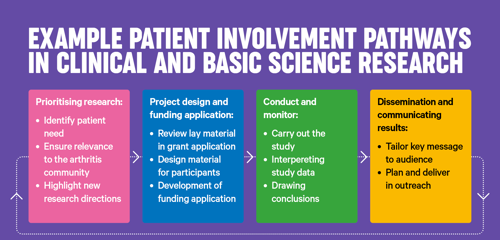Introduction
It can sometimes be hard to know where to start with Patient and Public Involvement, we have broken it down into these steps:
- Develop your research involvement PPI knowledge
- Plan your approach
- Ask for Help
- Reach out to people with lived experience of arthritis
Develop your research involvement knowledge - guides and training courses
PPIE Guides:
Versus Arthritis have developed this online PPIE Hub to guide researchers, from all disciplines and stages of their career, to navigate and include great involvement through all stages of the research cycle.
Diabetes UK have a useful guide for researchers to help with PPIE across different research disciplines. Although predominantly written for diabetes researchers, the knowledge is still relevant for MSK and arthritis researchers.
PPIE Training Courses
Imperial PPIE course: Public Involvement Training | Faculty of Medicine | Imperial College London
The Canadian Institute of Health Research have several training modules, including a video discussing six reasons to include patients in research: Patient Engagement - CIHR (cihr-irsc.gc.ca)
An Introduction and Practical Guide to Community Engagement and Involvement in Global Health Research: An Introduction and Practical Guide to Community Engagement and Involvement in Global Health Research • Global Health Training Centre (tghn.org)
Plan your approach
Start to outline a plan for how and when you’d like to involve people with lived experience of arthritis – it doesn’t need to be finished, as once you start you can discuss and finalise this plan together.
Developing an involvement plan before you begin will maximise the benefit of your activities and ensure that they are suitable and accessible for people with arthritis. This may seem daunting, to help you we have produced the following checklist of key things to take into consideration: Checklist (versusarthritis.org)
This template created by the Versus Arthritis Research Involvement team, can also support you in planning and considering how to involve people with arthritis in your research project or programme.
We have collated information to guide you at each stage of the research cycle.
Ask for help
Explore the support from your institution – do they have a PPI team that can help you? Are there others who have existing PPI groups or learning from their work?
Get in touch with us at researchinvolvement@versusarthritis.org with your questions.
Lobby and generate support from your university/institution - if there isn’t any support, make a request to the management team for links to existing PPI groups to be formed.
Reach out to people with experience of arthritis
- Some researchers may have links with patients or existing patient and community groups, which would be a great place to start. For those without pre-existing links, you could explore these options:
- Ask people you or your colleagues see in clinic (if relevant).
- We can put you in touch with our community of research partners, complete this form and send it to us if this would be useful.
- Use online channels that allow you to advertise PPI opportunities, such as Be Part of Research
- Social media through your institution or trust.
- Advertise in local community groups, local charities, GP surgeries etc.
- Visit community-based organisations whose members include people living with arthritis.
Other key elements to consider when reaching out:
- How you are going to keep people’s data safe and protect their privacy?
- Exploring incentives, e.g. potential payment for time, having their name on a research paper etc.
- Think about reasonable adjustments and removing barriers to participation, eg holding your meeting at a time of day when people with arthritis (PwA) have had adequate time to travel to the venue etc. This document gives advice on making research activities accessible and arthritis friendly.
Check out our page Diversity and Inclusion in PPIE Groups for additional guidance on how to reach a diverse spectrum of those with lived experience, including how to involve younger people.
How many people with arthritis to involve will vary, depending on the nature of the involvement activity you are planning.
In some cases, there may be a benefit to having a small number of patients involved throughout the course of the research project, for example one or two patients attending regular research meetings, or a single patient acting as a patient co-supervisor on a PhD research project. In other cases, such as reviewing grant proposals or taking part in discussions around future research priorities, it is useful to collect a more diverse range of opinions and feedback. It is important to note that quantity is not a substitute for quality, and that the number of individuals involved should be proportionate and appropriate to the nature of the activity
If you haven’t involved people with arthritis before, don’t be afraid to start small – arrange a meeting, invite people to attend your lab or give feedback on a conference abstract. It may also be your research partner’s first experience of being part of a PPI team too, so it can be helpful to get to know them and ask about their interest in being involved.
